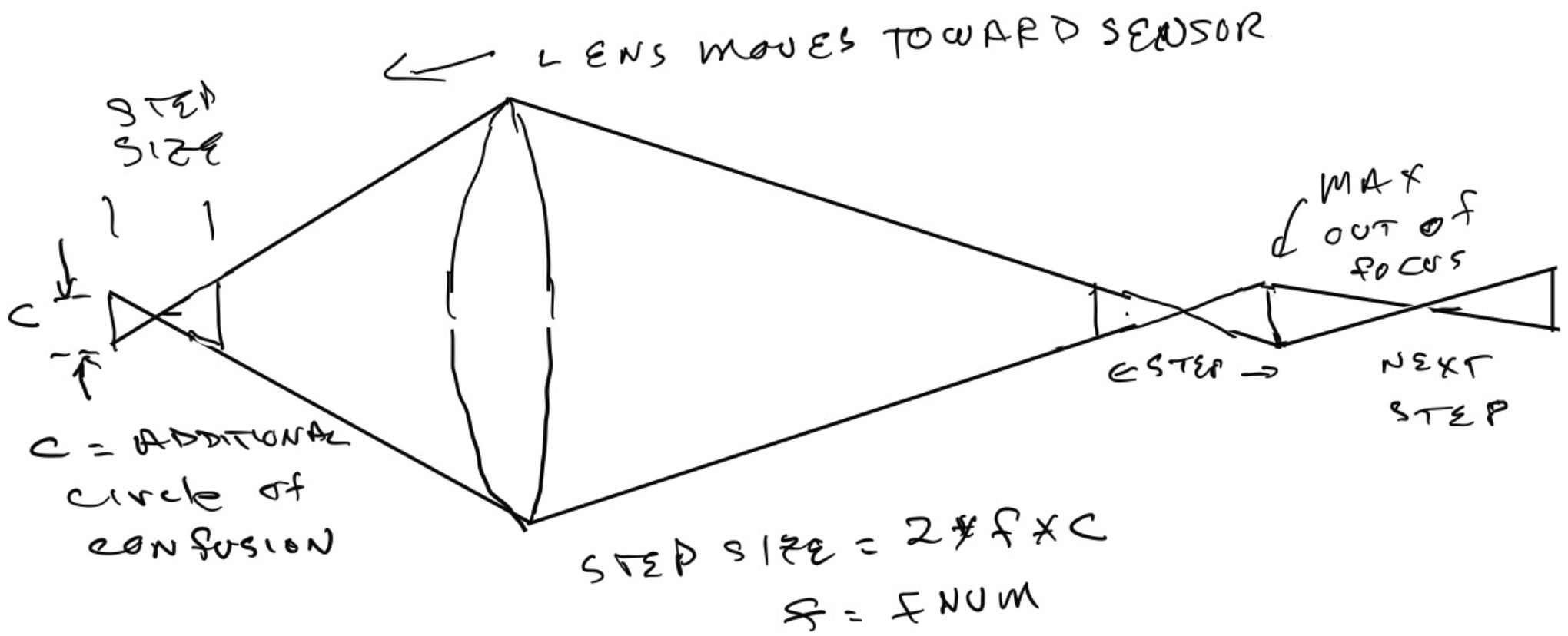Reader Comment: Fujifilm GFX100S/GFX100 Focus Stepping / Focus Stacking FOCUS BKT Algorithmic Error? Far Too Many Tightly-Focused Frames
re: focus stepping for focus stacking
re: Fujifilm GFX100: Bug and Issues with the FOCUS BKT Feature, How to Mitigate
Subscriber Norman Rogers Writes:
I just got my Fujifilm GFX 100S which is very similar for photo stacking to the APSC Fujifilm x-T4 camera that I also own. Panasonic and Nikon cameras have similar photo stacking features to the Fujifilm cameras. I am quite interested in focus stacking and I have a hobby site (normsphotoblog.com) with a lot of information on stacking.
I wrote an app that runs on a browser that helps in setting up stacking for various camera and lens combinations. It can be run on my website.
The theory of stacking via focus stepping is illustrated by this sketch:
 Sketch of optic with circle of confusion (CoC) size, focus stepping ideas
Sketch of optic with circle of confusion (CoC) size, focus stepping ideasA real camera lens is more complicated than the lens in the sketch, but this “thin lens” model gives a reasonable approximation except for macro lenses. When capturing a stack, the lens moves toward the sensor by uniform steps while the focal point on the right moves to further the right, taking bigger steps as the capture progresses. After each step a photo is taken.
Because the focus is off a bit midway between steps, the finer the steps the less out of focus is introduced. The additional circle of confusion is a measure of how much out of focus is added to the aberrations already existing in the lens. The camera automatically adjusts the step size in proportion to the f number. The Fujifilm x-T4 and GFX 100s have an additional parameter called STEP that multiplies the step size by 1 to 10. A similar system exists on Panasonic and Nikon cameras.
The additional circle of confusion is specified in microns, usually from 6 to25 microns. Even a perfect lens has a built-in circle of confusion, due to diffraction as the Airy Disc, given by 1.3 times the f number. This is 10 microns for a lens at f/8. CambridgeInColor.com explains more about diffraction. The spacing of the photo sites on many sensors is about 4 microns. This suggests that making the total circle of confusion less than 8 microns won’t help much.
The problem with the Fujifilm camera stacking is that the steps can’t be very large, resulting in far more frames than necessary. The biggest step is still too small for some applications. For example, the smallest and largest possible step on the Fujifilm x-T4 56mm lens at f/1.4 is as follows:
Smallest: .0019 millimeter
Largest: .019 millimeterBut using a Sigma 45mm f/2 lens on the Panasonic S1R:
Smallest: .014 millimeter
Largest: .14 millimeterIf the Sigma lens could go to f/1.4 the step size would be 30% smaller, or still five times larger than the step size on the Fujifilm camera. I believe a similar situation exists on the GFC 100s from some preliminary observations.
There are several ways Fujifilm could fix this problem. They could simply make the basic step size larger. They could make the response to the STEP index non-linear so that the size of the step would increase faster than the size of the index. Nikon uses an approach similar to that.
Sometimes it may be convenient to throw away every other picture in a stack, doubling the steps size. This saves processing time on the computer, but not stack acquisition time in the field. The easy trick for doing this on the Mac is to display the files as icons and then narrow the window to two icons wide. Then select one column.
DIGLLOYD: That’s at least three problems with Fujifilm GFX focus stacking support:
- Step size and hence too many frames;
- Never getting even close to INF with long lenses (fixed in recent firmware update?). FATAL problem in my past experience.
- Failure to reach INF with lenses having asymmetry or field curvature (fixed in recent firmware update?). Minor problem that results in loss of sharpness, typically in one corner.
All of this along with science fair projects give computational photography a black eye.























